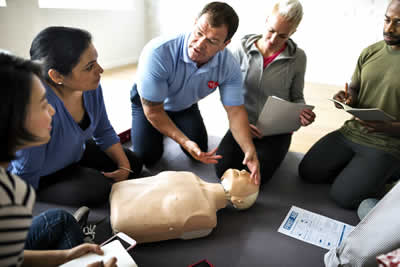Real safety goes far beyond regulations! Most companies display signs and file their compliance paperwork, but real safety is proven daily in what people do, say, and feel.
According to the International Labour Organisation, work-related dangers cause the deaths of about 2.78 million people each year. That’s more than 7,600 workers every single day, and many of these deaths happen in workplaces that “pass inspection.”
A genuine safety culture isn’t paperwork on a shelf, or ticking boxes. It’s a living system that protects your team, reputation ... and your bottom line.

How a Strong Safety Culture Boosts Employer Brand
Integrating safety into your corporate culture can do more than safeguard employees. It can become a strong instrument to promote your employer's brand and business image in general.
Once employees, candidates and clients realise that your company actually cares about it, they’ll realize that people come first in your organisation. And this will facilitate concrete outcomes:
Happy Employees Word-of-Mouth Referrals
Brand ambassadors are the employees who feel safe and cared about at their workplace. When their mental and physical health is put at the forefront, they tell positive tales to their relatives, acquaintances, and career groups.
This natural word of mouth can go a long way in improving your image as an employer of choice. Nowadays these recommendations are taken much more seriously than business or official promotion.
- Trust and loyalty develop in the workplace.
- On websites such as LinkedIn and Glassdoor, employees share their experiences regarding positive improvements in terms of safety.
- Good reviews will bring more like-minded candidates who appreciate well-being.
More Retention, Lower Turnover
A robust safety culture also has a direct impact on staff retention and turnover. Healthier and safer workplaces are characterized by better methods in the prevention of injuries and less absenteeism and stress cases.
This generates a more stable workforce and reduces the high costs of recruiting and training fresh employees. The
Occupational Safety and Health Administration (OSHA) states that employers receive reduced turnover by up to 20% when they have good safety programs.
- Fewer injuries imply fewer working days of loss and reduced disruptions.
- It increases job satisfaction as employees will feel valued.
- Consistent teams enhance production as well as workers' morale.

Attraction of Value Congruent Talent
In the modern world of employment, employees, particularly in the younger generations such as Millennials and Gen Z, are more likely to prefer a prospective employer that shares their values.
Authenticity demonstrates that your company takes the health of people seriously and respects it, which builds credibility and will make your organisation attract a pool of the highest-quality people.
- In an aggressive labour market, safety is a key differentiation.
- During interviews and their inquiry of the organisation, candidates analyse the safety environment.
- Long-term, ethical practices encourage employee involvement.
Greater Client and Partner Trustworthiness
It also
affects clients and business partners. Organisations who genuinely care evoke confidence since they reduce risks in operation and demonstrate corporate responsibility.
This has the potential to unlock new contract offers, alliances, and market shares, particularly in the construction, manufacturing, and energy, which are safety-sensitive industries.
- Clients don’t want to deal with irresponsible partners who have poor safety records.
- A good safety culture is a sign of good professionalism and perfect operation.
- Adherence to the rules minimizes financial and legal liability.
The TOP 10 steps to create an effective and lasting safety-first culture are as follows.
1. Make Safety a Core Company Value
It must be a day-to-day concern for managers and workers alike – not just a hidden line in a policy manual! You can attain it by including relevant metrics in all performance reviews. Use town halls to discuss safety goals alongside profit goals. Don’t forget to display real-time stats on noticeboards or dashboards. You can also share quarterly success stories highlighting employee contributions.
Example:
DuPont’s “Bradley Curve” shows how companies evolve from reactive to proactive cultures. By tying promotions to safety outcomes, DuPont has long surpassed industry averages for low incident rates.
2. Create an Empowered Workforce
A trust culture creates a sense of security. So that everyone can raise a voice reporting hazards, without the fear of censure or confrontation. In such a case, implement anonymous digital reporting tools for hazards and near-misses. Train managers to react constructively to reports – no blame, just fixes. Hold monthly feedback circles to encourage open sharing and recognise teams for transparent reporting, and making it zero incidents.
Example:
Toyota has a well-known Andon Cord, through which any line worker can halt production right away in case of unsafe or flawed workflows. This transparency keeps both workers and products safe.
3. Train for Reality, Not Theory
Dry lectures don’t stick! Training must prepare people for the real risks they face on the job. Enrol your site workers in a trusted
OSHA 10 online course. Make sure the course is flexible, context-specific and easy to learn. Conduct live drills on fire, chemical spillage or machine shut-down. You can invite industrial experts to carry out demo workshops. Learning itself is not enough! Use quizzes and interactive refreshers every quarter to get them practice.
 Example:
Example:
Boeing has adopted virtual reality in its mechanical schooling, simulating its critical systems. It helps ensure the engineers are prepared for emergencies before they ever encounter them.
4. Strengthen Emergency Response
Accidents do occur! However, prompt, efficient first responders can be the change between a close call and a tragedy. So, how do you do it? Encourage every employee to complete a certified
first aid certification course. Try to place emergency kits in clearly marked, accessible areas near work zones. You can assign “safety buddy” for monthly kit checks and hold surprise drills to test readiness.
Example:
Mayo Clinic suggests that first aid kits should remain visible, stocked, and checked regularly. However, they are not usable in most workplaces since they are locked up in cabinets.
5. Predict Problems Before They Happen
Smart businesses rely on live data, and forecasting applications to locate minor problems before they cause no big harm. You can also achieve it in your organization. All you have to do is: install sensors for gas leaks, temperature spikes, or equipment strain, and use hazard-reporting apps with instant photo uploads. Later, review the sensor data in weekly huddles and link recent predictive analytics trends to maintenance schedules.
Example:
Shell has AI-enabled predictive maintenance that monitors abnormal vibrations, leaks, and any change in pressure in oil rigs. It has dispelled expensive, risky shutdowns.

6. Celebrate Near-Misses, Don’t Bury Them
A near-miss is not a failure – it is a warning and a learning opportunity. Notice it before it becomes an accident. Make near-miss reporting a normal conversation topic and highlight lessons learned on staff noticeboards. Reward your workers for honest reporting with small thank-you gifts. Track how many near-miss reports turn into procedural improvements.
Example:
British Airways and other major airlines encourage open near-miss reporting. They also conduct regular meetings to examine trends and introduce solutions.
7. Protect Worker’s Mental Health
Fatigue and stress lower focus and increase errors. Keeping people mentally healthy is part of keeping them physically safe. But, how to do it? Provide brief mindfulness or break-stretching sessions every day. Train supervisors and workers about chronic stress or exhaustion. Allow workers to mind rest properly when there is so much pressure. Share mental health resources and support lines to each employee.
And the result? A safer, sharper, and more resilient workforce!
Example:
SAP runs a global mindfulness practice, with thousands of employees reporting better focus, fewer mistakes, and lower stress.

If you'd like to learn more about what we provide, why not take a look at how we can help?
Boost your skills with our market-leading online courses at super-low prices.
8. Reward Good Habits
Recognising safe actions encourages workers and builds a collective culture where safety becomes the norm. Make an award category for "Safety Star" of the month and provide modest incentives like espresso coupons or gift cards. Highlight winners in newsletters and noticeboards and tie team bonuses partly to positive stats. Because, positive reinforcement works! And, people repeat what you praise and reward.
Example:
BHP’s “Safety Leadership Program” rewards teams whose ideas improve safety, from redesigning tools to better PPE use.
9. Track What Predicts Safety, Not Just What Happened
Measuring accidents is backward-looking. Leading indicators like training rates and near-miss reports show you where to act first. Monitor near-miss accidents, hazard reports and workgroup safety meeting attendance. Display easy-to-understand and simple signs in the workplace. Review trends in leadership meetings each month and adjust goals based on fresh insights.
Example:
IBM uses leading indicators in its Health & Safety dashboards to spot where extra support is needed and to prevent incidents before they occur.
10. Practice Visible Leadership
The right culture thrives when leaders show up, ask questions, and act on feedback, not when they stay behind desks. Have managers spend time on the floor weekly – listening, not lecturing. Start meetings with a 5-minute “share” where you can invite executives to attend training sessions. Include real frontline stories in board updates. At the end of the day, practice makes everything perfect and harmless, too!
Example:
Firms like Caterpillar have implemented leadership safety walks in their culture. It is associated with significant declines in incident rates and better morale of employees.

Quick Action Checklist: Build Your Safety Culture Now
- Make safety part of leadership KPIs
- Train for real-life situations with practical tools like the OSHA 10 online course.
- Certify staff with a trusted first-aid certification
- Use smart tech to spot risks early
- Celebrate reporting and near-misses
- Support workers’ mental well-being
- Reward people for safe choices
- Measure leading indicators, not just accidents
- Refresh policies and learning regularly
Conclusion: Your Safety Culture is Your Legacy
Workplace safety is a promise more than a rule. A commitment to send each employee home safely at the end of the day. Organisations that act on this promise have loyal workforces, reduced expenses and better reputations.
Remember: every dollar invested in safety yields a saving of 4. Take your next step today towards a safe workplace culture. Rethink policies, refurbish training, conduct safety walks and ,above all, make sure that safety becomes the business of everyone.
Start now. Protect lives. Build trust. And make safety your legacy.






























